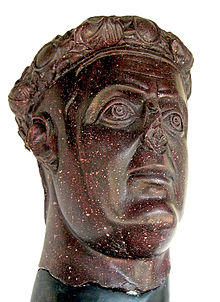
Back غاليريوس Arabic جاليريوس ARZ Qaleri Azerbaijani قالریوس AZB Галерый Byelorussian Галерий Bulgarian Galerius Breton Galeri Catalan Galerius Czech Galerius Welsh
| Galerius | |||||
|---|---|---|---|---|---|
 Patung dada Porfiri Galerius | |||||
| Kaisar ke-53 Bersama Kekaisaran Romawi | |||||
| Berkuasa | 1 Maret atau 21 Mei 293[1][2][3][4][5][6] – 1 May 305 (as Caesar, under Diocletian)[7] 1 May 305 – late April or early May 311 (as Augustus alongside Constantius (until July 25, 306) then Severus (until spring 307) then Constantine (from ca. September 307; unrecognized by Galerius' coinage from ca. September 307 to November 308) then Licinius (from 11 November 308))[2] | ||||
| Pendahulu | Maximian dan Diokletianus[7] | ||||
| Penerus | Maximinus, Konstantinus, dan Licinius[2] | ||||
| Kelahiran | ca. 260[2] Serdica[8] (Sofia, Bulgaria) | ||||
| Kematian | Akhir April atau awal Mei 311 (usia 51)[9] Serdica (Sofia), Bulgaria | ||||
| Pemakaman | |||||
| Pasangan | Galeria Valeria[2] | ||||
| Keturunan | Candidianus Valeria Maximilla, Maharani Romawi | ||||
| |||||
| Ibu | Romula (dituduh)[2] | ||||
Galerius Valerius Maximianus Augustus (sekitar 250 – April atau Mei 311) adalah Kaisar Romawi yang memerintah sebagai kaisar dari 305 hingga 311 M. Galerius adalah salah satu tokoh kunci dalam sistem Tetrarki, pemerintahan yang didirikan oleh Diokletianus untuk mengatur Kekaisaran Romawi. Ia dikenal karena perannya dalam melanjutkan penganiayaan terhadap umat Kristen, namun di akhir hidupnya, ia mengeluarkan edik yang mengakhiri penganiayaan dan memperbolehkan kebebasan beragama di kekaisaran.
- ^ Barnes, Constantine and Eusebius, pp. 8–9.
- ^ a b c d e f Barnes, New Empire.
- ^ Potter, The Roman Empire at Bay.
- ^ Southern, Severus to Constantine.
- ^ Williams, Diocletian.
- ^ The earlier dates for Galerius' appointment have been argued for based on the suggestion that the appointments of Constantius and Galerius were timed to coincide (Barnes 1981, 8–9; Southern 1999, 146). Barnes (1982, 62) argues against a dating of 21 May 293 in Nicomedia originating in Seston, Dioclétien, 88ff., stating that the evidence adduced (the Paschal Chronicle 521 = Chronica Minora 1.229 and Lactantius, DMP 19.2) is invalid and confused. Lactantius is commenting on Diocletian and the place where Diocletian was acclaimed, and that the "Maximianus" in the text is therefore a later gloss; the Paschal Chronicle is not authoritative for this period for events outside Egypt, and may simply be commenting on the day when the laureled image of the new emperors arrived in Alexandria. Potter (2004, 650) agrees that locating the acclamation to Nicomedia is false, but believes that Seston's other evidence makes a strong case for a temporal lag between the two Caesars' acclamations.
- ^ a b c Barnes, New Empire, p. 4.
- ^ Eutropius. Breviarivm historiae romanae, IX, 22 Diarsipkan 2017-09-10 di Wayback Machine. Templat:Ref-la
- ^ Lactantius, DMP 35.4. The exact date is lost in a lacuna (Barnes 1982, 6).
- ^ Kesalahan pengutipan: Tag
<ref>tidak sah; tidak ditemukan teks untuk ref bernamaBarnes, New Empire, p. 37